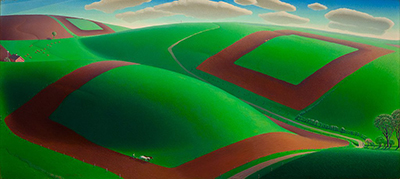Grant's unique style of nostalgic painting of the rural set up in America is seen in his painting Spring Turning. His style and founding myths in the country made him a star in the 1930s alongside other great artists like Thomas Hart Benton.
Spring Turning was created in 1936 and was first exhibited at Carnegie International Exhibition. Its medium, oil on Masonite and the exact current location remains a mystery.
Setting
Spring Turning is an impeccable painting that reflects a high horizon and a beautifully drawn line running along an overstated width of the composition ironically creating simultaneous feelings of compression and expansion in the depiction of the eastern Iowa landscape.
The main subject of this artistic work is the memorable landscape of Wood’s infantile in Anamosa, Iowa. The landscape is segmented to field for cultivation as the geometric demarcation is perceived as man-made by the plowed furrows. Every field is surrounded by posthole and you can notice the posts but not strung wires. The setting does not include any visual evidence of the twentieth epoch progress. No farm machinery, electric wires, automobiles or even paved roads. Wanda Corn, wood scholar, describes the painting as ‘man living in perfect harmony with nature and he is nature’s caretaker enticing her into abundance fetching coherence and impeccable beauty to her surfaces’.
Style and Technique
Avoiding the expressions of European art, Wood portrayed his innate Midwest with precision and clarity he spotted in Northern Renaissance art and melded these distinct styles into a unique American vision. Wood’s attention to detail is heightened by an almost undetectable brushwork and glazed surfaces. Details of this artwork were worked out in detail in preparatory drawing.
Wood created Spring Turning in oils and canvas bringing out the picture plane using careful brushwork of darker green for the fields and well squared strokes of dark sienna brown to reveal the plowed earth that smooth to ribbon in a distance. The spectator’s gaze is preserved within the composition by the tilt-up towards the picture lane which brings the effect of directing the gaze away from observation of details to appreciating the overall geometric setting of the landscape.
Influences and Inspirations
As he studied in Munich, Grant grew up admiring the Northern Renaissance artists Hans Memling, Hans Holbein and Jan van Eyck. The admiration is seen in most of his celebrated artworks. Grant was a creative artist who represented his work through normal farming set up especially since he grew up in such an environment. He has influenced many artists and his influence is felt in the art industry even today.




